
Are you prepared to catch the next big wave in blog traffic? Many marketers find themselves paddling hard but not making enough headway in attracting the right kind of visitors – those who are genuinely interested and engaged.
While there are several tried-and-true methods like the Skyscraper Technique, Google E-E-A-T principles, and white hat SEO to boost traffic, there’s a more natural, flow-based approach that taps into the very essence of human behavior.
Enter the Tidal Wave Technique. This isn’t just another strategy; it’s a fundamental shift in how you connect with your audience. By harnessing the natural rhythms and patterns of your readers, this technique elevates your blog to unprecedented heights. Imagine riding a wave that not only brings a surge in traffic but also enhances key metrics like return visits, search rankings, and time spent on your site.
This approach aligns perfectly with your business objectives, whether it’s lead generation, conversion, revenue growth, or establishing thought leadership. More importantly, it creates content that truly resonates with your audience’s needs and preferences.
The Tidal Wave Technique transforms the challenge of growing your blog from a steep uphill battle to a smooth, self-sustaining cycle. Are you ready to make a splash?
Quick Takeaways
- The Tidal Wave Technique leverages your audience’s natural online behavior patterns to significantly boost blog traffic and engagement.
- This strategy goes beyond just increasing page views, focusing on enhancing key website metrics like return visits, search rankings, and time spent on the page.
- By aligning your content creation with what your audience genuinely wants and needs, the Tidal Wave Technique ensures your blog delivers more value and relevance.
- Optimal timing and frequency of blog posts, based on audience behavior, are crucial for tapping into the full potential of your blog’s reach and influence.
- The Tidal Wave Technique is not just a quick fix but a sustainable approach to blog growth, turning the process into a self-perpetuating flow of increasing traffic and reader loyalty.
What is the ‘Tidal Wave Technique’?
The Tidal Wave is a marketing technique you can use to increase blog traffic and to get more people reading and following your blog. It applies to organic blog traffic that comes from Google search.
How does it work?
With The Tidal Wave, you optimize the frequency of your posts and the quantity of content. You do this by looking at existing web traffic data to understand when the troughs and crests are.
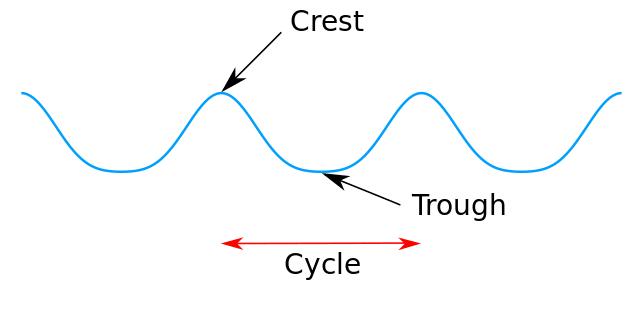
Image Source: Wikipedia
By reviewing your analytics to better understand consumer behavior in your industry, you can see when to change the frequency of your posts. You’ll also be able to identify opportunities for testing and refining your content marketing strategy.
What are tidal waves anyway and what do they have to do with blog traffic?
Tidal waves are formed by the push and pull of gravitational forces. They work in the same way as all immutable forces do.
There’s a regular, predictable, and never-ending flow of energy.
We’ve found the same immutable energy flow principle when analyzing the routine our blog readers appear to have.
It’s really fascinating when you start looking into this phenomenon with your own blog audience. We’ve found that our readership undulates with the days of the week in the same way that a tidal wave ebbs and flows.
So, we decided to capitalize on this inherent flow. We’re using a force that’s already existing and riding it, just like a surfer rides a wave.
Expand this principle further, and you can do even more with your blog traffic. Take tsunami waves as an example.
Tidal waves are different from tsunami waves. Tsunamis are caused by earthquakes on the ocean floor. They are less frequent, so they are more one-off events than something that will generate an ongoing effect.
But, because they are so powerful and rare, when they do happen, they tend to create a lasting impact.
In content marketing, a tsunami wave could be likened to a Google algorithm update or a really compelling marketing campaign. You’ll see a huge in-rush of traffic. It can be pretty overwhelming with a tsunami.
Then, even after the wave has passed, you’ll still have more readers simply because the tsunami event was so huge.
A tsunami can also be destructive. You may see this type of disastrous effect if your blog is knocked down as the result of an algorithm update.
Not the most exciting outcome. But, you can use even this to your advantage if you see it for what it is. An opportunity to identify where your blog isn’t strong. Then, you can let go of what isn’t working, rebuild, and improve what you have to create a blog that was even more effective than pre-tsunami.
Who should use the tidal wave technique?
The tidal wave is for you if you want to increase:
- Blog traffic
- Time on page
- Your number of return visitors
Because it’s so effective at helping marketers achieve an ongoing boost to blog traffic, it’s useful for almost any situation. As long as you already have some blog traffic, you can channel your experience and research to create the tidal wave effects.
The tidal wave is also a perfect fit when you notice telltale signs that your content marketing is falling flat. For example, if your search results are dropping off. Or, if you’re seeing declining page views, social media shares, or revenue. Even if you’re simply plateauing – it’s time to do something.
What the tidal wave is not
The tidal wave is not a substitute for creating best-in-class content.
You still need to focus on SEO best practices. You still need to use a well-thought-out blogging plan to make sure you’re publishing customer-focused content.
Quality should still be at the heart of your blog creation. But, with the tidal wave technique, you won’t have to put in more effort and increase your content quality even more in order to increase traffic. You’ll simply keep doing what you’re doing.
We’ll talk more about what you can do to ensure your content creation and SEO are already at a high level later on. Then, when you combine a killer blog with the wave, that’s where you can take your blog to a whole new level with increasing traffic and readership.
Benefits of the tidal wave
In 2023, one in four bloggers reported achieving “strong results” from their blogging efforts.
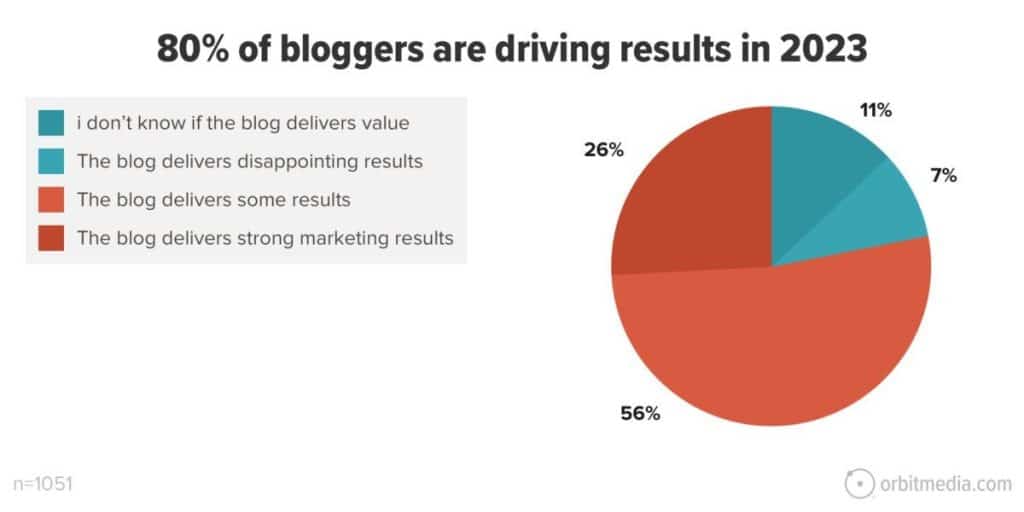
Image Source: Orbit Media
By delivering content that resonates with the audience’s needs and preferences, the Tidal Wave Technique enhances the overall blog experience, making it even more appealing and relevant to readers.
What’s unique about the tidal wave technique is, you can achieve dynamic results. This is because you aren’t just getting more page views and impressions. You’re also working to increase the time your readers spend on the page and to attract more return visitors.
The tidal wave also:
- Increases Reader Engagement and Loyalty. As a result of a more effective blog experience, readers are more likely to engage with the content, sign up for newsletters, and develop loyalty to the blog.
- Encourages Higher Content Sharing. Satisfied and engaged readers are more inclined to share blog posts within their networks, further amplifying the reach and impact of the content.
- Provides Data-Driven Audience Service. This technique uses analytics to understand and cater to audience preferences, ensuring that the content strategy is continuously aligned with what readers want and need.
- Continuously Improves of Blog Metrics. By consistently refining the timing and approach based on analytics, the Tidal Wave Technique helps in continuously improving key blog metrics like bounce rate, average session duration, and conversion rates.
- Positively Impacts the Bottom Line. The overall impact of this technique is not just limited to traffic and engagement metrics but also extends to the blog’s bottom line, potentially leading to increased revenue opportunities.
What this means is you’re delivering a more effective blog experience for your readership. So, they stick around. They sign up for your newsletter and come back for more. They share your posts with their network.
You aren’t simply achieving exciting blog traffic numbers. You’re using your analytics to better serve your audience. As you keep using the tidal wave and refining your timing, you’ll continue to see an increasingly positive impact on your blog metrics. And on your bottom line.
How to Use the Tidal Wave to Increase Blog Traffic
To get started with this technique, you’ll need to do some research. Look at your Google Analytics traffic metrics and figure out where your wave patterns are.
These wave patterns reveal your audience’s behavior trends. As long as you have regular blog traffic, you’ll be able to spot the patterns easily.
What we observed when looking at many of the websites we work with – especially with the blogs that post regularly – are traffic peaks on Monday and Tuesday.
Traffic usually starts to wane by Wednesday.
Then the bottom is on Saturday.
You can see the same pattern for Marketing Insider Group whether you’re looking at organic search traffic or all traffic. It’s a distinct peak on Monday and Tuesday. A trough every Saturday. Sunday traffic starts to pick up. And then the pattern starts all over again.
Take a look at the tidal wave pattern for organic search. The arrows are pointing to Monday each week.
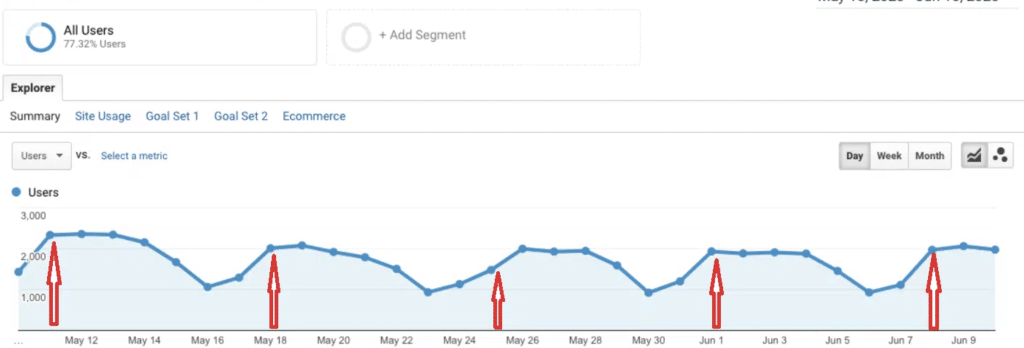
The same pattern happens with all traffic:

Here’s a screenshot of the MIG Search Console for the last 28 days. You can see that Impressions come down at the end of the week as well. And we know from looking at the blog traffic pattern, this is because fewer people are searching.
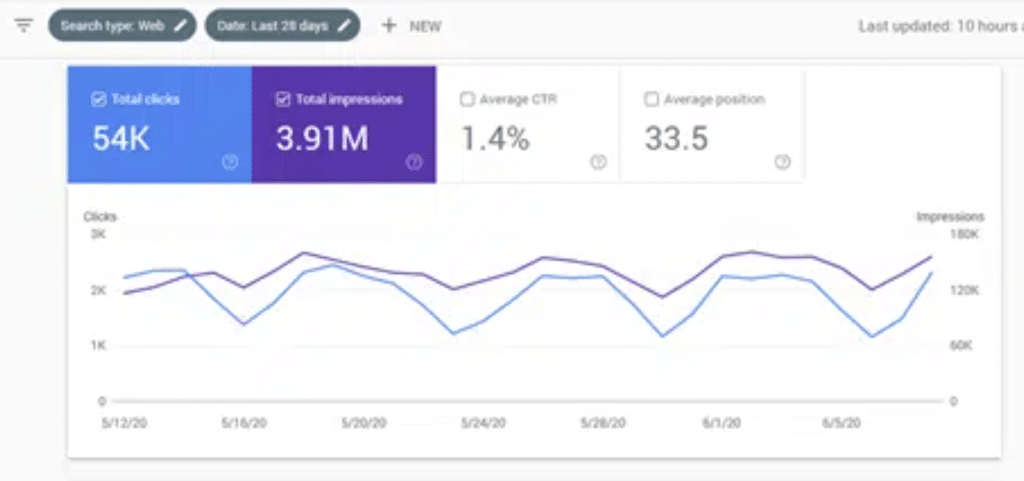
For client traffic, the pattern is a little less obvious. But, it’s still there:
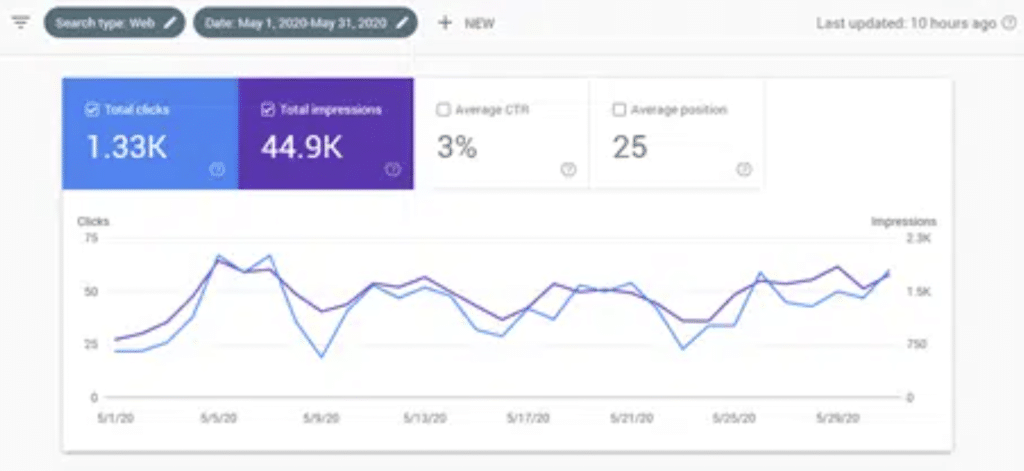
How to Ride the Wave
So, how can you leverage this wave to increase your readership?
To put the tidal wave into action, what you do is match your post publishing time to your site visits. This is the essence of the technique.
Weekly publishing times
Let’s say you normally publish eight posts every week. Typically what marketers do is spread out their blog publishing. You might post two on Monday and one every other day of the week to create a constant flow of new content on your site.
Instead of spreading out your posts evenly, ride the wave. In this case, your publishing schedule would look like this:
- Three on Monday
- Two on Tuesday
- Two on Wednesday
- One on Thursday
This is the schedule we use at Marketing Insider Group.
If you normally publish fewer blogs each week, that’s okay too. You can still use the wave effect to increase your readership. For four a week, your schedule would look like this:
- Two on Monday
- One on Tuesday
- One on Wednesday
Whatever your ideal blog posting frequency is, revolve it around your audience’s habits.
What you’re doing then is posting when there are more people searching. Take a look at the search trends for the search term ‘content marketing.’ There is always a peak in interest – and Google search activity – early in the week.
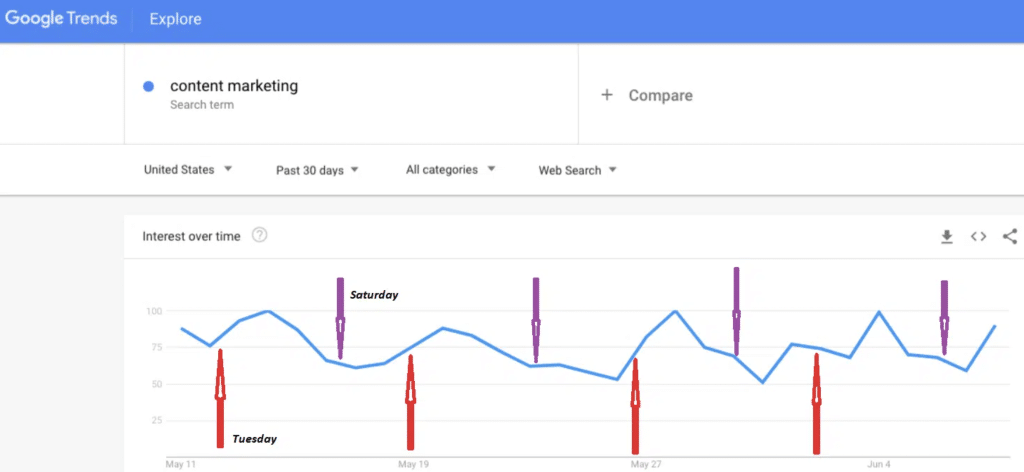
The red arrows point to Tuesday. You can see there’s always an early-week increase on Monday or Tuesday. The purple arrows show Saturday. You’ll notice there’s always a slow down at the end of the week for ‘content marketing’.
What about Friday? Should your blog really take the day off?
Friday is actually a prime day for publishing end-of-week content. To make the most out of the tidal wave, you’ll want to take advantage of this day. We’ll talk more about Friday later.
Daily publishing times
You also want to factor in the time of day. What is the best time to automate blog posts for your audience?
Study the times when people come to your site by looking at Google Analytics. If they come in the morning, publish early. If they visit in the mid-afternoon, publish then.
For ‘content marketing,’ a 3 to 5 am ET publishing time works well.

Keep in mind, different industries will have their own right timing. Also, your audience may follow patterns that vary from the norm in your industry – not to mention natural changes that are going to occur over time. So, be sure to continue tracking the search trends that are relevant to your audience, and to your own blog traffic trends.
Leveraging Visual Content
You know that they say… timing is everything. But, in this case, so are engaging visuals.
In a world where attention spans are short and competition for eyes on screen is fierce, visual content has emerged as a kingpin in driving blog engagement and traffic. Here’s how integrating visual elements into your blog can make a significant difference:
- Captivating First Impressions: Humans are visual creatures, and an engaging image or graphic can be the difference between a reader staying on your page or moving on. High-quality, relevant images grab attention and can make your posts more inviting and readable.
- Simplifying Complex Information: Infographics and charts are excellent for breaking down complex data or concepts into digestible visuals. This not only aids in understanding but also makes your content more shareable, as people love to share insightful, easy-to-grasp visuals.
- Enhancing Social Media Shares: Content with images gets 94% more views than content without. When readers share your posts on social media, the accompanying visuals make the shares stand out in crowded feeds, driving more traffic back to your blog.
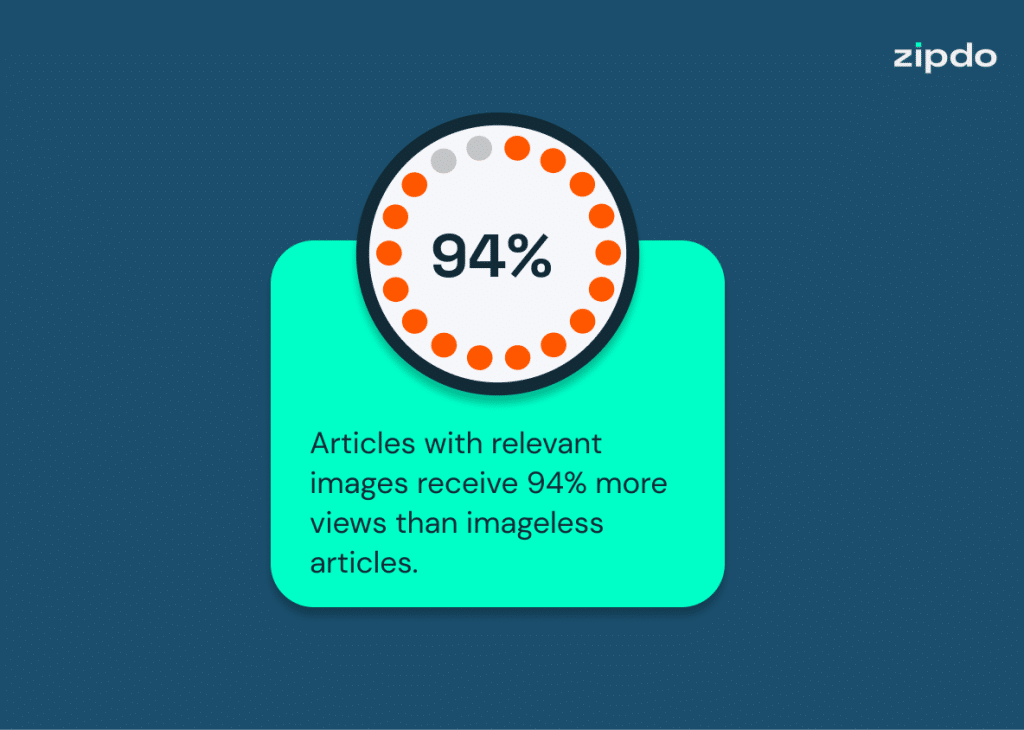
Image Source: ZipDo
- Improving SEO: By optimizing images with alt text and descriptive file names, you enhance your blog’s SEO. Visuals can appear in image searches, opening up another channel for potential traffic to your site.
- Boosting Engagement and Retention: Videos and interactive media can significantly increase the time visitors spend on your site. Engaging visual content keeps readers on your page longer, reducing bounce rates and signaling to search engines that your content is valuable.
- Encouraging Emotional Connections: A well-chosen image or a short video can evoke emotions, making your content more memorable and relatable. This emotional resonance can foster a deeper connection with your audience.
- Supporting Brand Identity: Consistent use of colors, styles, and types of images can reinforce your brand identity. Over time, your audience starts associating these visual elements with your content, enhancing brand recognition and loyalty.
- Facilitating Accessibility and Inclusivity: Visual content can make your blog more accessible to people with certain disabilities, as well as those who prefer visual learning styles, thus widening your audience base.
By weaving these visual strategies into perfect peak timing, you not only enhance the aesthetic appeal of your content, but also significantly improve your chances of riding the wave. Remember, in the world of content marketing, a picture is not just worth a thousand words; it could be worth a thousand clicks.
Know Your Traffic Sources to Optimize Your Tidal Wave Timing
Is most of your organic traffic coming from Google?
Study all of your channels and traffic sources to gain a clear understanding of your audience’s behavior trends.
In rare cases, you could end up with more traffic from Facebook or another platform. This will impact your wave pattern. There are also specific external factors that can skew your tidal wave. For example, if you provide stock market data, your blog traffic is going to revolve around trading hours.
Boost your tidal wave with social media
You can give your blog traffic an additional boost with social media. Share your posts right after you publish your blog.
Save time by automating your marketing process instead of doing it manually. You can schedule your blog posts to publish at 5AM and then set your social media posts at the right time based on your industry, your audience, and the norm for your preferred social media sites.
Share your blog posts on Instagram for fashion, beauty, and lifestyle brands.
Use X for marketing and political niches. X is also prime territory if your goal is to encourage more comments.
As a general rule of thumb, Gary Vee suggests brands work hard and smart to post a lot of quality content often. You can work this into your posting schedule to boost your traffic even more.
Video Source: Gary Vee
The important thing here with riding the wave is that you keep feeding your analytics research and your experience into the equation. Pay attention to the wave patterns. Watch for anomalies, tsunami waves, and other changes.
The more you do this, the easier it is to recognize patterns. You’ll clearly see where you can tweak your timing or your strategy to achieve even better results.
Now that you have the essentials of the tidal wave technique down, let’s jump into the ‘tube ride’ and have even more fun.
Leveraging the Tube Ride: The Ultimate Surfing Move and a Powerful Strategy for Your Blog
When you have all the right conditions in the water, a wave will form a cylinder or tube shape before it breaks. When this happens, a surfer can ride the center of the barrel. They are literally riding through a moving tube of water.

Image Source: Medium
Ask any experienced surfer and they’ll tell you, the tube ride is an incredible experience. And, it makes all the time and hard work they put into improving their surfing skills more than worth it.
In marketing, you can create a ‘tube ride’ when all the elements of your blog come together to achieve brilliant results.
Here’s how to do it:
1. Start with great content
For the tube ride and the tidal wave technique to be effective, you need to start with great content.
- As with all of your marketing, focus your blog content on what matters to your target customers. Answer their questions. Solve their problems. Offer helpful insights that are relevant to their lifestyle.
- Use thought leadership. Dig deep with your blog posts to offer expert-level information. Aim to publish the best posts out there on every topic you write about.
- To get backlinks to your blog, use the Skyscraper Technique. Having high-quality backlinks is an important part of SEO, so this technique can be excellent for boosting your search rankings.
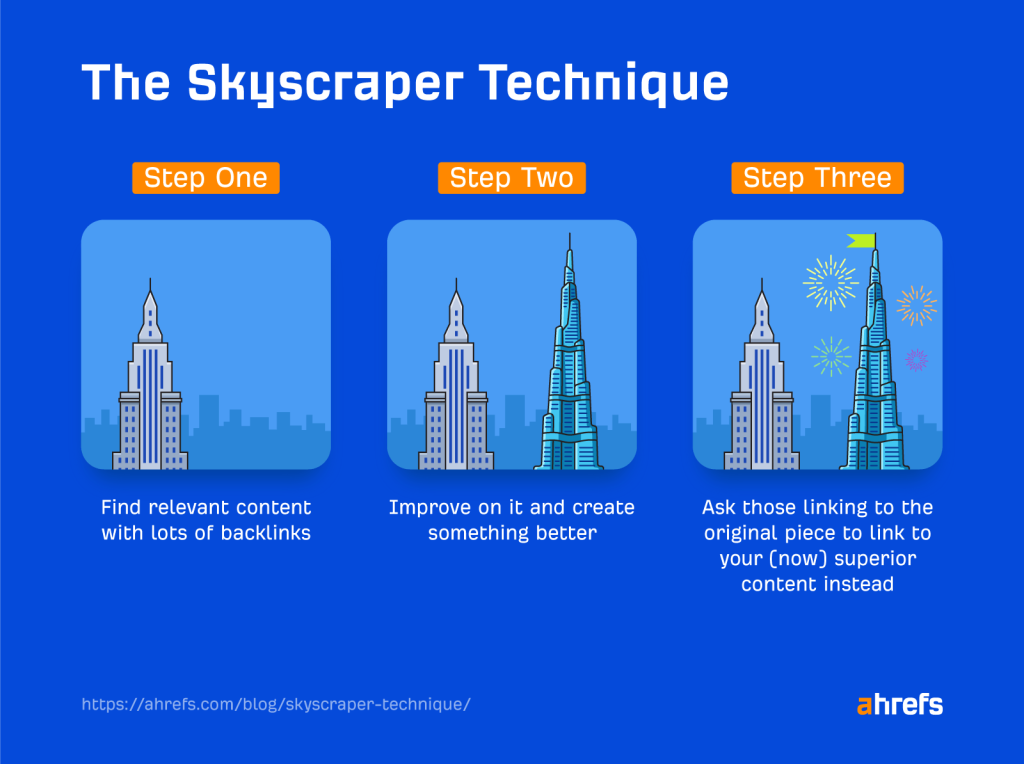
Image Source: Ahrefs
- Keep current SEO best practices in mind when developing content for your blog:
- Google wants to know your blog is written by an expert.
- That it has authority in your industry, which happens when authority sites are linking to your blog or mentioning it, and when you have a lot of social media shares.
- It also needs to be trustworthy. Google looks at factors such as transparency on your site and linking out to authority external sources to determine how trustworthy your blog is.
2. Adapt to consumer behavior
With great content, you have the right conditions. Now, to turn your tidal wave into a tube ride, you need to adapt to your audience.
Here’s the thing. Consumer behavior for any industry changes slowly. If you don’t notice those small, incremental changes, you may not realize your content marketing is falling apart.
It’s like the frog in a pot of water. If you put the frog in the water while it’s lukewarm, it won’t notice the slowly rising temperature until it’s too late. Ouch!
Don’t let this happen to your blog.
Instead, be adaptable and keep pivoting in ways that will help you to maintain those optimal tube ride conditions.
Try changing the frequency of your posts. Watch your analytics to see if posting more or less each week makes a difference. The reality is, what worked well four months ago might not be your best strategy right now because your audience’s behavior has changed.
- If you already have a massive blog library, try lowering your publishing frequency. Then, focus on optimizing the old posts and doing more keyword research for new posts.
- If not, try increasing your frequency. You may have to hire domain experts or a content writing service for this.
Look at your return visitors and your new visitors separately. The reason you should do this is you want to figure out if you have two different groups with unique reading habits. For example, you may find out you need to publish short-form advanced content for your repeat visitors. Your new visitors may be more interested in comprehensive evergreen content.
Pay attention to what’s going on in your industry. And, what’s going on in the world. Be sensitive to topics and come up with ways to offer hope, inspiration, and helpful tips that revolve around what’s going on.
And finally, find your balance with your blog posts. You need to focus on quality and quantity, conversions and ROI. Everything isn’t going to always go in the same direction. But, striking the best balance possible for your brand is how you’ll get your ‘tube ride.’

Double Up the Wave – And Your Blog Traffic
A ‘double up’ is a surfing term used to describe one large wave followed by a smaller wave.
As part of the tidal wave marketing technique, a ‘double up’ is when you create a small spike in traffic on Friday or Saturday. Or whichever day your blog traffic wave reaches its lowest point.
By leveraging your low traffic day to publish or share a type of content that resonates with your audience’s end-of-week mindset, you can create a second, smaller traffic spike each week.
When you double up, you’re getting even more out of your tidal wave, creating more momentum for your blog. You’re also capturing your audience when they are in a different mindset, which can lead to different results.
For example, as Neil Patel has pointed out, Mondays may get the most blog traffic, but you may see the most social shares and comments on Saturdays. This is because people have more time to browse the internet and engage. During the week, they may only have time to read your blog post, get the information they need, and move on.
Here’s how doubling up works:
- Identify the day you see your weekly dip. For most blogs, this will be the end of the workweek.
- Choose a fresh format that’s different from your blog post and publish or share that content on your low day. This is your ‘double up.’
- Then, test. Keep refining your ‘double up’ content until you get that second wave.
Here are some ideas you can use. You can try one, two, or all of the below. Just be sure to track your blog metrics when you try something different.
1. Newsletter
Do you send out an email newsletter once a week? If Friday is your low day, send it on Friday to generate a traffic spike. Try sending it around 3 pm as this will give your readers enough time to look at your newsletter and click over to your blog before leaving the office.
Experiment with the time and with the layout of your newsletter. For example, you can try sending it at 1 pm instead of 3 pm for six weeks and then track what happens. This could help you reach more readers in a different time zone.
2. Social media
To attract the end-of-week attention, make your social media post really interesting. You can make it visually appealing. For example, post a series of images, publish an infographic or another illustration, or make your post a weekly roundup.
You can also use a different tone. It’s the end of the week, so make your social posts on Friday inspiring or even entertaining rather than your typical educational content.
3. Podcast series
Create a weekly podcast or vlog to talk about what happened this week in your industry. This can be a great way to engage with your audience at the end of the week when they’re not necessarily going to sit and read a blog but they’d love to listen to what you have to say.
Keep Refining Your Tidal Wave
Once you get your tidal wave going, the way to keep it moving is to continually test.
Change your posting frequency. Add a podcast to your weekly content plan. Make your newsletters shorter. Alter the look and tone of your social media posts on Mondays, Fridays, or at noon.
As you experiment, keep watching your relevant blog and business metrics. These include:
- Pages per visit
- Time on page
- Bounce rate
- Unique visitors
- Visitor to subscriber ratio
- Conversion rate
And, only commit to what you can handle. The reality is, if you try to post too much, you’ll get burnt out. You could also see your quality drop.
Find your balance. Rely on outside expert help when you need it. And never stop getting out there and riding those waves.
Increase Blog Traffic with the Tidal Wave Technique Today
If you’re serious about increasing blog traffic, the Tidal Wave Technique is a powerful and strategic choice. It aligns your posting schedule with your audience’s online behavior and enhances content with visually appealing elements.
This method goes beyond mere numbers; it’s about creating content that resonates and builds lasting reader engagement. By continuously refining your approach based on analytics, you’ll see a sustained positive impact on your blog’s performance and audience loyalty.
Ready to increase blog traffic with the Tidal Wave Technique? Check out our SEO Blog Writing Service or schedule a quick consultation to learn more about how Marketing Insider Group can help you earn more leads for your business.
0 Commentaires